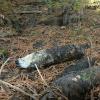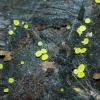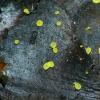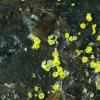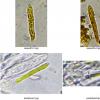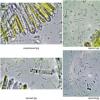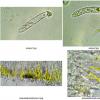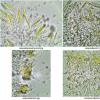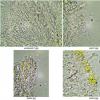
16-11-2015 12:29
 Bernard CLESSE
Bernard CLESSE
Sur le même cône pourri d'épicéa, un asco jaun

15-11-2015 16:23
Gilbert MOYNEBonsoir,Sur des crottes de chamois en culture, j'a

13-11-2015 21:42
 Björn Wergen
Björn Wergen
Hi there,I have another problem, found on attached

12-11-2015 23:55
Hi all,some days ago I thought on died sproutes of

13-11-2015 18:47
 Björn Wergen
Björn Wergen
Hi friends,I have collected Skeletocutis carneogri
Asco sur cône pourri d'épicéa
Bernard CLESSE,
16-11-2015 12:29
 Sur le même cône pourri d'épicéa, un asco jaune citron :
Sur le même cône pourri d'épicéa, un asco jaune citron :a) asques IKI+
b) paraphyses cylindriques à contenu jaune
c) spores étroitement ovales-fusiformes : 6-8x3
Une idée ?
Bernard
Hans-Otto Baral,
16-11-2015 12:42

Re : Asco sur cône pourri d'épicéa
Hi Bernard
This is Hamatocanthoscypha uncipila, but it is a bit difficult. There is a white and a yellow form, which might be different species. See my folder "uncipila yellow".
The hairs should be distinctly hooked at the flanks, could you please check this detail?
A similar species, H. sulphureocitrina, has inamyloid asci and is on angiosperm substrate.
Zotto
This is Hamatocanthoscypha uncipila, but it is a bit difficult. There is a white and a yellow form, which might be different species. See my folder "uncipila yellow".
The hairs should be distinctly hooked at the flanks, could you please check this detail?
A similar species, H. sulphureocitrina, has inamyloid asci and is on angiosperm substrate.
Zotto
Bernard CLESSE,
16-11-2015 16:51
Hans-Otto Baral,
16-11-2015 16:57

Re : Asco sur cône pourri d'épicéa
your last photo shows curved hairs (poils 1 and 2). Yes of course, uncipila.
I wrote nonsense, the white form is Hamatocanthoscypha conincola which hardly differs except for its colour.
I wrote nonsense, the white form is Hamatocanthoscypha conincola which hardly differs except for its colour.
Bernard CLESSE,
16-11-2015 17:03

Re : Asco sur cône pourri d'épicéa
OK Zotto, great thanks.
Bernard
Bernard



